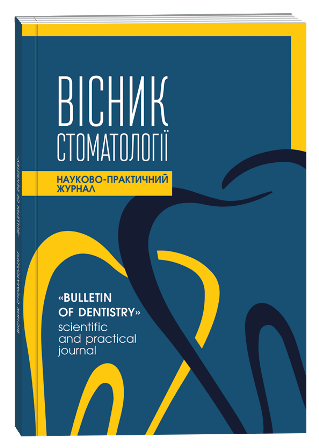IMPROVING METHODS.COMPLEX METHOD OF TREATMENT OF TORTOANOMALY IN CASE OF BORING TEETH
DOI:
https://doi.org/10.35220/2078-8916-2024-51-1.2Keywords:
tortoabnormality, density, relapse of tooth turn, circumferential supracrestal fiberotomy, papilla splitting, quality of life, oral health, periodontal disease, orthodontic treatment, gingival margin, adults, dentoalveolar anomalies.Abstract
Purpose of the study. Our study is aimed at determining the effectiveness of methods that prevent the recurrence of tortoanomalia – circular supracrestal (supragingival) fibrotomy (CSF) in patients aged 16 years and older and the effect of CSF on the gingival junction in the treatment of tortoanomalia with fixed orthodontic multibonding equipment. Therefore, the aim of our study is to evaluate the effectiveness of the use of circular supracrestal (supragingival) fibrotomy in the treatment of tortoanomalia to increase the effectiveness of treatment, prevent relapses and increase the stability of the achieved result. Materials and methods. To do this, we examined 23 patients aged 16 years and older who were treated with non-removable multibonding equipment. The mean age of patients at the start of treatment in the CSF group and the control group was 16.0±1.5 and 15.8±1.3 years, respectively. The mean treatment period was 21.5±4.4 months for the CSF group and 23.3±1.3 months for the control group. All 23 patients used fixed devices until an optimal bite was formed. Of these, 11 patients underwent circular supracrestal fibrotomy in the frontal region of the upper and lower jaw 5 weeks before removing the fixed equipment, 12 patients were a control group. 5 patients in the CSF study group and 6 patients in the control group were treated with premolar removal. The method of fibrotomy involves dissection of vestibular and lingual transeptal fibers, semicircular fibers located between the cement and the alveolus, and multidirectional fibers stretched between the cement of one tooth and the free gingival edge of the proximal adjacent tooth. Thus, intergingival, transgingival, transseptal, and semicircular fibers are susceptible to dissection during CSF. The periodontal condition in all patients at the time of surgery was within the normal range, before surgery, oral sanitation and professional oral hygiene procedures were performed. Results. After treatment, changes in the tilt of the incisors of the lower and upper jaw were minimal. Conclusion. Clinical results show that CSF is effective in preventing recurrence of pie abnormalities and in treating crowding of teeth during retention periods of 6 months and 1 year. There is also the possibility that relapse may continue in later years, especially in the dental arch on the lower jaw. Crowding of teeth may increase regardless of the treatment method in all orthodontic patients due to the normal growth process. Prevention of early relapses of tortoanomaly abnormalities with CSF prevents late relapse and leads to a more stable stable long-term outcome of tortoanomaly treatment in crowded teeth.
References
Sarah Turner, Jayne E Harrison, Fyeza NJ Sharif, Darren Owens, & Declan T Millett. (2021). Orthodontic treatment for crowded teeth in children. Published by John Wiley & Sons, Ltd. https://doi.org/10.1002/14651858. CD003453.pub2
Araghi, S., Sharifi, R., Ahmadi, G., Esfehani, M., & Rezaei, F. (2015). The Study of Prescribing Errors Among General Dentists. Glob J Health Sci. 8(4), 32-43 doi: 10.5539/gjhs.v8n4p32
Schneider-Moser, U.E.M., & Moser, L. (2022). Very early orthodontic treatment: when, why and how? Dental Press J Orthod., 27(2), e22spe2. doi: 10.1590/2177-6709. 27.2.e22spe2.
Martin, C., Littlewood, S.J., Millett, D.T., Doubleday, B., Bearn, D., Worthington, H.V., & Limones, A. (2023). Retention procedures for stabilising tooth position after treatment with orthodontic braces. Cochrane Database Syst Rev.б 5(5), CD002283. doi: 10.1002/14651858. CD002283.pub5.
Kalha, A.S. (2016). Orthodontic retention to have and to hold. Evid Based Dent., 17(4), 105-106. doi: 10.1038/sj.ebd.6401200.
Liu, C., Wei, Z., Jian, F., McIntyre, G., Millett, D.T., Lai, W., & Wang, Y. (2024). Initial arch wires used in orthodontic treatment with fixed appliances. Cochrane Database Syst Rev., 2(2), CD007859. doi: 10.1002/14651858. CD007859.pub5
Shah, A.A. (2003). Postretention changes in mandibular crowding: a review of the literature. Am J Orthod Dentofacial Orthop. 124(3), 298-308. doi: 10.1016/ s0889-5406(03)00447-5.
Lopes, Filho, H., Maia, L.H., Lau, T.C., de Souza, M.M., & Maia, L.C. (2015). Early vs late orthodontic treatment of tooth crowding by first premolar extraction: A systematic review. Angle Orthod., 85(3), 510-7 doi: 10.2319/050814-332.1.
Al-Jasser, R., Al-Subaie, M., Al-Jasser, N., & Al-Rasheed, A. (2020). Rotational relapse of anterior teeth following orthodontic treatment and circumferential supracrestal fiberotomy. Saudi Dent J., 32(6), 293-299 doi: 10.1016/j.sdentj.2019.10.003.
Will, L.A. (2016). Stability and Retention. Front Oral Biol., 18, 56-63 doi: 10.1159/000353098









